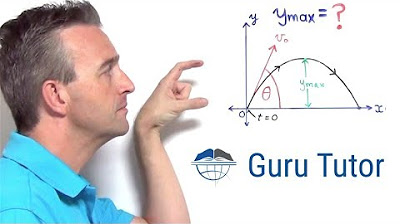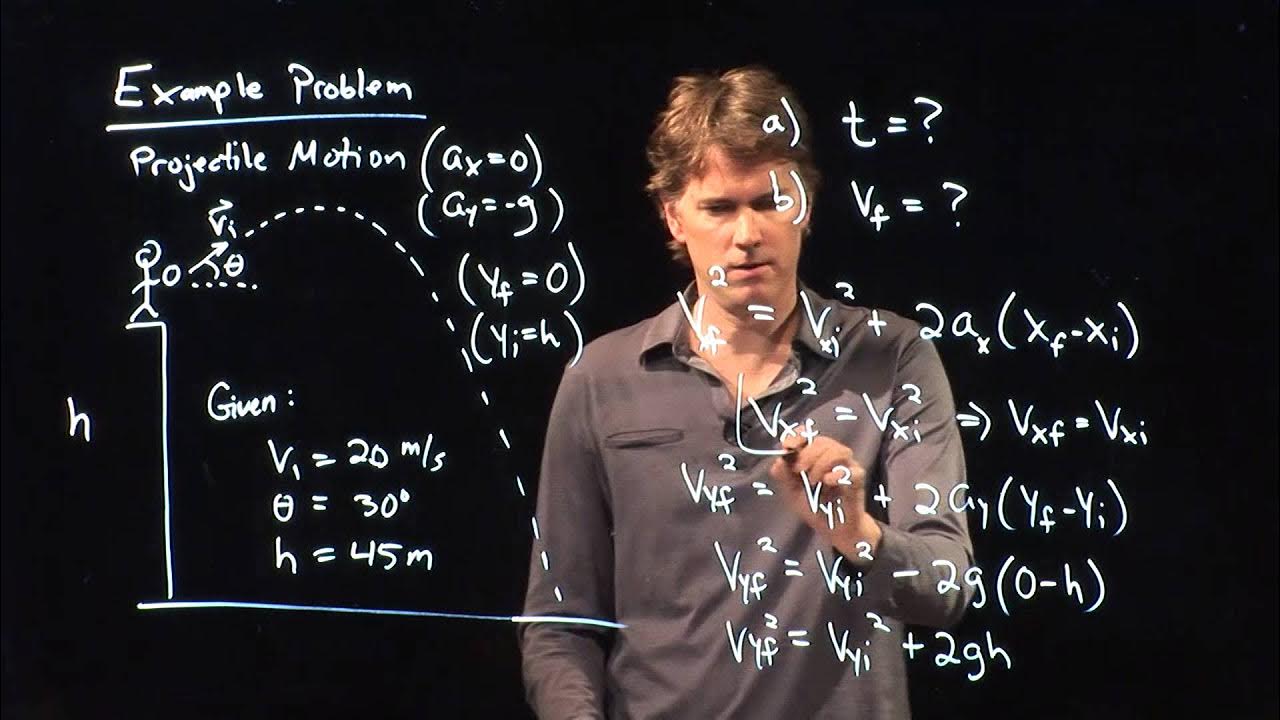No Calculus Needed?! How to Maximize Range Using Simple Geometry.
TLDRThe video script delves into the physics of projectile motion, particularly focusing on optimizing the launch angle for maximum horizontal distance when throwing an object from a tall building. It explains that while a 45-degree angle is ideal on level ground, this isn't necessarily the case from a height. The key insight is that maximizing the area of the velocity triangle (formed by the initial, final, and change in velocity vectors) leads to the maximum distance. The video reveals that the ideal launch angle is when the angle between the starting and ending velocities is 90 degrees, and it can be calculated using the inverse tangent of the initial velocity over the final velocity. This engaging explanation combines practical observation with mathematical derivation to provide a clear understanding of projectile motion.
Takeaways
- 🌟 The optimal angle for throwing a projectile to maximize distance is not always 45 degrees, especially when thrown from a height.
- 🔢 To calculate the best angle, one should consider the height of the building and the strength of the throw, as these factors influence the projectile's trajectory.
- 🎯 The horizontal component of the velocity remains constant throughout the flight, as gravity only affects the vertical component.
- 🚀 The final distance is determined by multiplying the total airtime by the horizontal velocity.
- 📐 The velocity vector can be split into horizontal and vertical components, with the horizontal component indicating the rate of movement away from the building.
- 🌐 The conservation of energy principle ensures that the speed of the projectile when it hits the ground is independent of the throw angle.
- 🔽 The area of the velocity triangle (upper side representing the throw velocity, lower side the ground impact velocity) is related to the throw distance.
- 📈 Maximizing the area of the velocity triangle corresponds to maximizing the distance, which occurs when the angle between the starting and ending velocities is 90 degrees.
- 📐 The ideal launch angle can be calculated using the inverse tangent of the initial velocity over the final velocity.
- 🏗️ Ideal conditions for this calculation include ignoring air resistance and assuming the curvature of the earth is negligible, sticking to Newtonian physics.
- 💡 Estimating the building's height and the throw's strength can provide a good approximation of the required throw to achieve maximum distance.
Q & A
What is the initial thought process of someone throwing a projectile from a tall building?
-The initial thought process involves estimating the distance to a target, such as a river, and attempting to throw a small object like a projectile to reach that target without considering the physics involved in achieving maximum distance.
Why does the 45-degree angle not always apply when throwing from a height?
-The 45-degree angle is optimal for throwing on level ground because it provides an equal distribution of energy between horizontal and vertical components of velocity. However, when throwing from a height, the significant vertical drop and the strength of the throw become factors, and the optimal angle may vary to compensate for these elements.
What assumptions are made in the script for the physics of the projectile motion?
-The script assumes ideal conditions with no air resistance, negligible earth curvature, and adherence to Newtonian physics. It also assumes that the throwing speed can be consistent across different angles.
How does the horizontal component of the velocity affect the projectile's flight?
-The horizontal component of the velocity remains constant throughout the flight because gravity, which is the only force acting in the ideal scenario, acts only in the vertical direction. This constant horizontal velocity contributes to the total distance traveled by the projectile.
What is the relationship between the area of the velocity triangle and the distance thrown?
-The area of the velocity triangle, calculated as one-half the product of the base (final velocity) and the height (horizontal velocity), is directly proportional to the distance thrown, differing only by a factor of one-half the gravitational acceleration (g).
At what angle does the distance thrown maximize according to the script?
-The distance thrown maximizes when the angle between the starting and ending velocities is 90 degrees, forming a right triangle, which indicates that the launch angle should be the inverse tangent of the initial velocity over the final velocity.
How can one estimate the ideal launch angle based on the script's explanation?
-By estimating the height of the building and the strength of one's throw, one can determine the initial and final velocities and use the inverse tangent function to calculate the angle that will result in the maximum distance.
What additional factors could affect the projectile's distance in a real-world scenario?
-In a real-world scenario, factors such as air resistance, non-uniform gravity due to the Earth's shape and variations in terrain, and wind conditions could affect the projectile's distance and trajectory.
Why is the conservation of energy principle important in this projectile motion analysis?
-The conservation of energy principle ensures that the kinetic energy of the projectile when it hits the ground is equal to the sum of the kinetic energy of the throw and the potential energy from the starting height, assuming no energy loss to air resistance. This principle allows us to treat the magnitudes of the initial and final velocities as constants when finding the optimal launch angle.
How does the concept of vectors contribute to understanding the projectile's motion?
-Vectors are used to represent the projectile's velocities in both horizontal and vertical directions. By analyzing the changes in these vector components throughout the flight, we can understand how the velocity's direction and magnitude are affected by gravity and use this information to determine the optimal conditions for maximizing distance.
What role does the final velocity's angle upon hitting the ground play in maximizing the distance?
-The angle of the final velocity upon hitting the ground, which is rotated 90 degrees from the launch angle, is crucial because it indicates that the projectile has reached the maximum possible distance given its initial height and velocity. This understanding helps in calculating the ideal launch angle for achieving maximum distance.
Outlines
🚀 Understanding Projectile Motion from a Tall Building
This paragraph delves into the physics behind projectile motion, specifically when launched from a tall building. It begins with a relatable scenario of throwing an object towards a river from a rooftop, highlighting the common misconception that a 45-degree angle is optimal regardless of height. The discussion transitions into a more technical analysis, introducing variables and diagrams to calculate the time spent in the air and the distance traveled. It emphasizes the importance of considering both the horizontal and vertical components of velocity, and how they are affected by gravity. The paragraph concludes with the realization that the problem can be approached by focusing on the velocity vector and its changes throughout the projectile's flight, setting the stage for the next section's exploration of maximizing distance.
📈 Maximizing Distance with the Velocity Triangle
The second paragraph focuses on using the concept of a velocity triangle to find the optimal launch angle for maximizing distance. It explains that the area of this triangle, which is related to the projectile's horizontal velocity and the change in velocity due to gravity, can be used to determine the best angle. The key insight is that the distance is maximized when the angle between the starting and ending velocities is 90 degrees, forming a right triangle. This allows for the application of trigonometric relationships to calculate the ideal launch angle. The paragraph concludes by suggesting that with an estimate of the building's height and an understanding of one's throwing capability, one can achieve maximum distance, assuming ideal conditions and no air resistance.
Mindmap
Keywords
💡Projectile
💡Angle of Launch
💡Parabolic Path
💡Velocity
💡Gravity
💡Air Resistance
💡Newtonian Physics
💡Horizontal Velocity
💡Velocity Triangle
💡Conservation of Energy
💡Optimal Launch Angle
Highlights
The discussion begins with a relatable scenario of throwing a projectile from a tall building, aiming to maximize the distance thrown.
The optimal angle for throwing a projectile is not always 45 degrees, especially when considering height and the force of the throw.
The problem is approached by analyzing the velocity of the projectile rather than its position, using vectors to represent the velocity components.
The horizontal component of the velocity remains constant throughout the projectile's flight due to the absence of air resistance and the assumption of constant throwing speed at any angle.
The total distance thrown can be calculated by multiplying the horizontal velocity by the total air time, which is a key insight for maximizing distance.
The velocity triangle, consisting of the initial and final velocities, provides a visual representation of how the velocity changes throughout the projectile's flight.
The speed of the projectile when it hits the ground is independent of the throw angle, due to the conservation of energy in the ideal scenario.
The area of the velocity triangle is related to the distance thrown, and maximizing the area corresponds to maximizing the distance.
The maximum distance is achieved when the angle between the starting and ending velocities is 90 degrees, revealing a right triangle relationship.
The ideal launch angle can be determined using the inverse tangent of the initial velocity over the final velocity, providing a practical formula for optimal throwing.
The problem-solving approach involves a combination of physics principles, mathematical analysis, and geometric insights.
The assumption of negligible earth curvature and air resistance simplifies the problem while maintaining its theoretical integrity.
The method presented can be applied to real-world scenarios with adjustments for height and throwing strength.
The discussion emphasizes the importance of understanding the underlying physics to solve complex problems.
The use of diagrams and variables to define and solve the problem demonstrates a clear, step-by-step approach to problem-solving.
The transcript concludes with a practical application, suggesting that with an estimate of building height and throwing strength, one can achieve maximum distance.
Transcripts
Browse More Related Video

Why Does 45º Launch Angle Give Maximum Range? // HSC Physics

Projectile launched off a cliff at an angle

Projectile Motion Maximum Height Formula Derivation

Projectile Motion Example - How fast when it hits the ground

Projectile Launched of a Cliff

Projectile Motion - Maximum Range Angle - Physics & Calculus
5.0 / 5 (0 votes)
Thanks for rating: